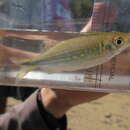Diagnostic Description
provided by Fishbase
Devario malabaricus differs from all its congeners by the combination of the following characters: absence of process on 1st infraorbital; body depth 27-35 %SL; predorsal scales15-17; dorsal fin with 11½-12½ branched rays; anal fin with 12½-17½ branched rays; presence of danionin notch; origin of dorsal fin to hypural distance when carried forward falling well short of posterior border of eye; tip of pectoral fin almost reaching origin of pelvic fin when adpressed; snout length subequal to or greater than eye diameter; P stripe originating level with pelvic-fin origin, 1-2 scale-widths anterior to dorsal-fin origin; P-1 stripe less than half width of P stripe, bifurcated anteriorly by a more or less broken whitish line; 5-6 dark, irregular, vertical bars on the anterior half of body; and absence of nuptial tubercles in both sexes (ref. 118056).
- Recorder
- Christine Marie V. Casal
Life Cycle
provided by Fishbase
Spawns in shallow water, among marginal weeds and roots usually after heavy rains. Eggs are light orange and sticky; more than 200 eggs are laid and hatch in 1-2 days. Fry are free-swimming on fifth day. Exhibits cannibalism on eggs (Ref. 6028).
Morphology
provided by Fishbase
Dorsal soft rays (total): 12 - 16; Analsoft rays: 15 - 20; Vertebrae: 34 - 36
- Recorder
- Christine Marie V. Casal
Trophic Strategy
provided by Fishbase
Found in a variety of habitats from boulder-strewn mountain torrents to small pools in dry zone streams. Most common in flowing water than in reservoirs and tanks. Forms medium sized shoals and prefers flowing water. Feeds on terrestrial insects and detritus. Exhibits cannibalism on eggs (Ref. 6028). Rarely reaches 12 cm (Ref. 41236).
- Recorder
- Drina Sta. Iglesia
Biology
provided by Fishbase
Found in a variety of habitats from boulder-strewn mountain torrents to small pools in dry zone streams. Most common in flowing water than in reservoirs and tanks. Forms medium sized shoals and prefers flowing water. Feeds on terrestrial insects and detritus. Spawns in shallow water, among marginal weeds and roots usually after heavy rains. Eggs are light orange and sticky; more than 200 eggs are laid and hatch in 1-2 days. Fry are free-swimming on fifth day. Exhibits cannibalism on eggs (Ref. 6028). Rarely reaches 12 cm (Ref. 41236).
Importance
provided by Fishbase
fisheries: of no interest; aquarium: highly commercial

